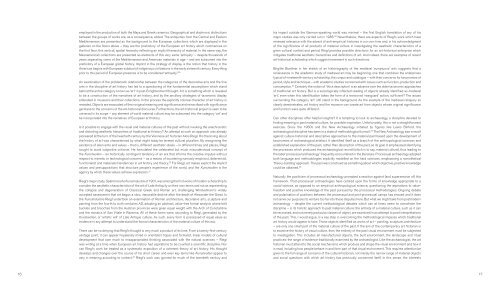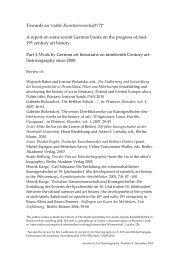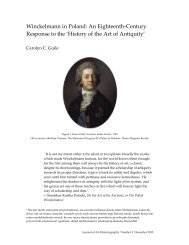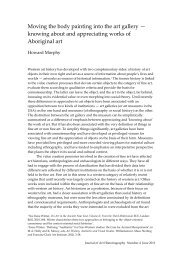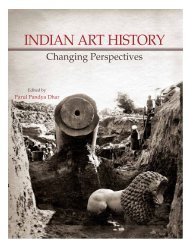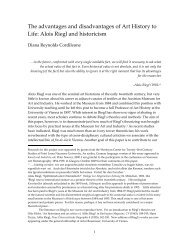Relics of Another Age: Art History, the - Journal of Art Historiography
Relics of Another Age: Art History, the - Journal of Art Historiography
Relics of Another Age: Art History, the - Journal of Art Historiography
You also want an ePaper? Increase the reach of your titles
YUMPU automatically turns print PDFs into web optimized ePapers that Google loves.
employed in <strong>the</strong> production <strong>of</strong> both <strong>the</strong> Maya and Greek ceramics. Geographical and diachronic distinctions<br />
between <strong>the</strong> groups <strong>of</strong> works are, as a consequence, elided. The antiquities from <strong>the</strong> Central and Eastern<br />
Mediterranean are presented as <strong>the</strong> background to <strong>the</strong> European collections which are displayed in <strong>the</strong><br />
galleries on <strong>the</strong> floors above – <strong>the</strong>y are <strong>the</strong> ‘prehistory’ <strong>of</strong> <strong>the</strong> European art history which commences on<br />
<strong>the</strong> first floor, this vertical, spatial hierarchy reflecting an implicit hierarchy <strong>of</strong> material. In <strong>the</strong> same way, <strong>the</strong><br />
Mesoamerican collections are presented as elements <strong>of</strong> this very same ‘antiquity’ – despite thousands <strong>of</strong><br />
years separating some <strong>of</strong> <strong>the</strong> Mediterranean and American materials in age – and are subsumed into <strong>the</strong><br />
prehistory <strong>of</strong> a European global history. Implicit in <strong>the</strong> strategy <strong>of</strong> display is <strong>the</strong> notion that history in <strong>the</strong><br />
Americas begins with European subdual <strong>of</strong> indigenous civilizations in <strong>the</strong> early sixteenth century. Everything<br />
prior to this period <strong>of</strong> European presence is to be considered ‘antiquity’. 29<br />
An examination <strong>of</strong> <strong>the</strong> problematic relationship between <strong>the</strong> categories <strong>of</strong> <strong>the</strong> decorative arts and <strong>the</strong> fine<br />
arts in <strong>the</strong> discipline <strong>of</strong> art history has led to a questioning <strong>of</strong> <strong>the</strong> fundamental assumptions which stand<br />
behind <strong>the</strong> entire category known as ‘art’ in post-Enlightenment thought. <strong>Art</strong> is something which is revealed<br />
to be a construction <strong>of</strong> <strong>the</strong> narratives <strong>of</strong> art history, and by <strong>the</strong> ancillary strategies <strong>of</strong> taxonomic display<br />
embodied in museums and <strong>the</strong>ir collections. In <strong>the</strong> process <strong>the</strong> explicitly colonial character <strong>of</strong> art history is<br />
revealed. Objects are evacuated <strong>of</strong> <strong>the</strong>ir original meaning and significance and reinscribed with significance<br />
germane to <strong>the</strong> concerns <strong>of</strong> <strong>the</strong> art-historical discourse. Fur<strong>the</strong>rmore, <strong>the</strong> art-historical project is seen to be<br />
universal in its scope – any element <strong>of</strong> world material culture may be subsumed into <strong>the</strong> category ‘art’ and<br />
be incorporated into <strong>the</strong> narratives <strong>of</strong> European art history.<br />
Is it possible to engage with <strong>the</strong> visual and material cultures <strong>of</strong> <strong>the</strong> past without invoking <strong>the</strong> anachronistic<br />
and distorting aes<strong>the</strong>tic hierarchies <strong>of</strong> traditional art history? An attempt at such an approach was already<br />
pioneered at <strong>the</strong> turn <strong>of</strong> <strong>the</strong> twentieth century by <strong>the</strong> Viennese art historian Alois Riegl. His <strong>the</strong>orising about<br />
<strong>the</strong> history <strong>of</strong> art was characterised by what might today be termed cultural pluralism. By recognising <strong>the</strong><br />
existence <strong>of</strong> alien aims and values – that is, different aes<strong>the</strong>tic ideals – in different times and places, Riegl<br />
sought to avoid subjective criticism. He formulated <strong>the</strong> celebrated but much misunderstood concept <strong>of</strong><br />
<strong>the</strong> Kunstwollen – an historically contingent tendency <strong>of</strong> an era that informs <strong>the</strong> creative impulse without<br />
respect to mimetic or technological concerns – as a means <strong>of</strong> countering narrowly empiricist, determinist,<br />
functionalist and materialist tendencies in art history and <strong>the</strong>ory. 30 For Riegl, art makes explicit <strong>the</strong> implicit<br />
values and presuppositions that structure people’s experience <strong>of</strong> <strong>the</strong> world, and <strong>the</strong> Kunstwollen is <strong>the</strong><br />
agency by which <strong>the</strong>se values achieve expression. 31<br />
Riegl’s major study, Spätrömische Kunstindustrie <strong>of</strong> 1901, was among <strong>the</strong> first works <strong>of</strong> modern scholarship to<br />
consider <strong>the</strong> aes<strong>the</strong>tic characteristics <strong>of</strong> <strong>the</strong> art <strong>of</strong> Late Antiquity on <strong>the</strong>ir own terms and not as representing<br />
<strong>the</strong> collapse and degeneration <strong>of</strong> Classical Greek and Roman art, challenging Winckelmann’s widely<br />
accepted assessment that art began a slow, inexorable decline after <strong>the</strong> death <strong>of</strong> Alexander <strong>the</strong> Great. In<br />
<strong>the</strong> Kunstindustrie Riegl undertook an examination <strong>of</strong> Roman architecture, decorative arts, sculpture and<br />
painting from <strong>the</strong> fourth to sixth centuries AD, adopting an abstract, value-free formal analysis where belt<br />
buckles and brooches from <strong>the</strong> Austrian provinces were given equal weight with <strong>the</strong> Arch <strong>of</strong> Constantine<br />
and <strong>the</strong> mosaics <strong>of</strong> San Vitale in Ravenna. All <strong>of</strong> <strong>the</strong>se forms were, according to Riegl, generated by <strong>the</strong><br />
Kunstwollen, or ‘artistic will’ <strong>of</strong> Late Antique culture. As such, every form is possessed <strong>of</strong> equal value as<br />
evidence in any attempt to understand <strong>the</strong> formal characteristics <strong>of</strong> <strong>the</strong> material culture <strong>of</strong> this era.<br />
There can be no denying that Riegl’s thought is very much a product <strong>of</strong> its time. From a twenty-first-century<br />
vantage point, it can appear hopelessly mired in orientalist tropes and formalist, linear models <strong>of</strong> cultural<br />
development that owe much to misappropriated thinking associated with <strong>the</strong> natural sciences – Riegl<br />
was writing at a time when European art history had aspirations to be counted a scientific discipline. Nor<br />
can Riegl’s work be treated as a systematic exposition <strong>of</strong> a coherent <strong>the</strong>ory <strong>of</strong> art history. His thought<br />
develops and changes over <strong>the</strong> course <strong>of</strong> his short career and even key terms like Kunstwollen appear to<br />
vary in meaning according to context. 32 Riegl’s work was ignored for much <strong>of</strong> <strong>the</strong> twentieth century and<br />
his impact outside <strong>the</strong> German-speaking world was minimal – <strong>the</strong> first English translation <strong>of</strong> any <strong>of</strong> his<br />
major studies was only carried out in 1985. 33 Never<strong>the</strong>less, <strong>the</strong>re are aspects <strong>of</strong> Riegl’s work which have<br />
renewed relevance with <strong>the</strong> advent <strong>of</strong> anti-empiricist histories in our own time and, in his acknowledgment<br />
<strong>of</strong> <strong>the</strong> significance <strong>of</strong> all products <strong>of</strong> material culture in investigating <strong>the</strong> aes<strong>the</strong>tic characteristics <strong>of</strong> a<br />
given cultural context and period, Riegl provides possible directions for an art-historical enterprise which<br />
mitigates traditional aes<strong>the</strong>tic hierarchies and definitions <strong>of</strong> art. And indeed, <strong>the</strong>re are examples <strong>of</strong> recent<br />
art-historical scholarship which suggest movement in such directions.<br />
Brigitte Buettner in her sketch <strong>of</strong> an historiography <strong>of</strong> <strong>the</strong> medieval ‘sumptuous’ arts suggests that a<br />
renaissance in <strong>the</strong> academic study <strong>of</strong> medieval art may be beginning; one that combines <strong>the</strong> enterprises<br />
typical <strong>of</strong> nineteenth-century scholarship, <strong>the</strong> corpus and catalogue – with <strong>the</strong>ir concerns for taxonomies <strong>of</strong><br />
period, style and technique – with academic studies concerned with issues such as function, production and<br />
consumption. 34 Certainly <strong>the</strong> notion <strong>of</strong> ‘thick description’ is an advance over <strong>the</strong> older taxonomic approaches<br />
<strong>of</strong> traditional art history. But is a sociologically inflected reading <strong>of</strong> objects already identified as medieval<br />
‘art’, even when this identification takes <strong>the</strong> form <strong>of</strong> a revisionist ‘rearguard’ action, sufficient? The issues<br />
surrounding <strong>the</strong> category ‘art’ still stand in <strong>the</strong> background. As <strong>the</strong> example <strong>of</strong> <strong>the</strong> medieval reliquary so<br />
clearly demonstrates, art history and <strong>the</strong> museum can create art from objects whose original significance<br />
and function were quite different.<br />
Can o<strong>the</strong>r disciplines <strong>of</strong>fer helpful insights? It is tempting to look to archaeology, a discipline devoted to<br />
finding meaning in past material culture, for possible inspiration. Unfortunately, this is not a straightforward<br />
exercise. Since <strong>the</strong> 1960s and <strong>the</strong> New Archaeology initiated by figures like Lewis Binford, <strong>the</strong><br />
archaeological discipline has been in a state <strong>of</strong> methodological turmoil. 35 The New Archaeology saw a revolt<br />
against culture-historical and descriptive approaches to <strong>the</strong> material past based upon <strong>the</strong> development <strong>of</strong><br />
taxonomies <strong>of</strong> archaeological artefact. It identified itself as a branch <strong>of</strong> <strong>the</strong> anthropological sciences and<br />
established explanation <strong>of</strong> <strong>the</strong> past, ra<strong>the</strong>r than description <strong>of</strong> <strong>the</strong> past, as its goal. It emphasised identifying<br />
<strong>the</strong> processes which produced <strong>the</strong> archaeological record (which is to say, material culture), thus leading to<br />
<strong>the</strong> label ‘processual archaeology’ frequently encountered in <strong>the</strong> literature. Processual archaeology adopted<br />
both language and methodologies explicitly modelled on <strong>the</strong> hard sciences, emphasising a nomo<strong>the</strong>tical<br />
‘<strong>the</strong>ory-building’ approach. The past was construed as something about which objective, positive knowledge<br />
could be obtained. 36<br />
Naturally <strong>the</strong> positivism <strong>of</strong> processual archaeology prompted a reaction against (and supersession <strong>of</strong>) this<br />
framework. ‘Post-processual’ archaeologies have centred upon <strong>the</strong> forms <strong>of</strong> knowledge appropriate to a<br />
social science, as opposed to an empirical anthropological science, questioning <strong>the</strong> aspirations to valuefreedom<br />
and positive knowledge <strong>of</strong> <strong>the</strong> past pursued by <strong>the</strong> processual methodologies. Ongoing debate<br />
and polarisation <strong>of</strong> positions between <strong>the</strong> processual and post-processual camps has ensued and it does<br />
not serve our purposes to venture too far into <strong>the</strong>se disputes here. But what we might take from postmodern<br />
archaeology – despite <strong>the</strong> current methodological debates which can at times seem to overwhelm <strong>the</strong><br />
discipline – is its holistic approach to past material culture: <strong>the</strong> entirety <strong>of</strong> a material culture, such as it can<br />
be recovered, and not merely particular classes <strong>of</strong> object, are examined in an attempt to posit interpretations<br />
<strong>of</strong> <strong>the</strong> past. This, I would argue, is a key step in overcoming <strong>the</strong> methodological impasse which traditional<br />
art history would appear to face. Those objects identified as works <strong>of</strong> art – painting, sculpture, architecture<br />
– are only one small part <strong>of</strong> <strong>the</strong> material culture <strong>of</strong> <strong>the</strong> past. If <strong>the</strong> aim <strong>of</strong> <strong>the</strong> contemporary art historian is<br />
to examine <strong>the</strong> history <strong>of</strong> visual culture, <strong>the</strong>n <strong>the</strong> entirety <strong>of</strong> <strong>the</strong> past visual environment must be subjected<br />
to investigation. This includes all manufactured objects, <strong>the</strong> built environment, <strong>the</strong> landscape and ritual<br />
practices: <strong>the</strong> range <strong>of</strong> evidence traditionally examined by <strong>the</strong> archaeologist. Like <strong>the</strong> archaeologist, <strong>the</strong> art<br />
historian must attend to <strong>the</strong> social mechanisms which produce and shape <strong>the</strong> visual environment and how it<br />
is read, including how people behave in and form part <strong>of</strong> that visual environment. This requires attention be<br />
given to <strong>the</strong> full range <strong>of</strong> concerns <strong>of</strong> <strong>the</strong> cultural historian, not merely <strong>the</strong> narrow range <strong>of</strong> material objects<br />
and social questions with which art history has previously concerned itself. In this sense, <strong>the</strong> interests<br />
16 17


